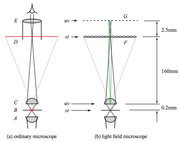Spring 2012:LFM
Contents
Light Field Microscopy
Vincent Lee
Statement of Interest
The idea of this project lies behind the combination of two imaging methods, confocal microscopy and light-field projection imaging. Confocal uses a method of angle restriction to select out a singular plane of focus, relying on an iris to restrict the light from the subject. Light-field imaging allows a reconstruction of light angles onto the the sensor through the combination of a physical setup and a collection of algorithms.
The idea behind this new combination of technologies lies in switching the physical iris in a confocal microscope with a virtual iris constructed in post- processing. This will allow for specific and total selection fo all light directions, allowing for full characterization of the material being imaged. This may also allow selective focus between near focal planes, all post- process, and captured in the same amount of time as a normal confocal.
I have little background in implementation of these technologies, but I have studies the theories and am eager to implement them myself. I have recently become very intrigued by light-field approaches to imaging, since it adds a new scale of data (angular) that can be gained in exchange for pixel resolution. I feel that light-field technologies are just starting to be truly implemented, and I would like to push one edge of the development myself.
During the course of this lab I intend to:
- Build a simple test apparatus for light-field imaging & develop methods of processing the .
- Design & construct a confocal microscope.
- Implement prior light field processing to extend to new apparatus.
Leanna Morinishi
Light field imaging allows for the capture of the light field of a sample in a single photograph.[1] This has been recently commercialized in the Lytro Camera[2] which obtains a light field using a microlens and allows for processing of the image afterwards.
They also documented their setup in more detail in a technical memo.[4]
Introduction to LFDisplay.[5]
Light field rendering.[6]
In 2009, the group published a better quality machine 4D Microscopy[7]
Objectives
I'm Leanna, a senior in Course 20. I find all sorts of things fascinating which is both a joy and a nuisance. Through 309, I began to better understand the impact of improved imaging tools on fundamental movements in the field, and I would love to broaden this learning experience to at least 3 new imaging- or measurement- related approaches this term. As a scientist, I really feel like I need to better understand not just the function of the scopes available commercially, but also the physical concepts and limitations associated with them. Specifically I'd like to learn more about image processing and/or 3D imaging. I think it would be great to be able to track cell migration or other small movements in 3 dimensions over time with the parts available to us in the 309 lab. I believe that my final project will be in light field imaging[1] a technology recently seen in the Lytro Camera. See my final project page for more details.
I would be thrilled to work on this project for a number of reasons:
- It will force me to work on image processing, I am novice status :p
- It would be an awesome project
- It is feasible
- Only one additional physical component in a traditional bright field microscope
- Lots of code
- It is relevant
- This microscope can be used to compose a 3-dimensional image of the sample
- Taking 3-dimensional images quickly is a current point of interest in microscopy today
- It is novel
- With respect to this class, this is a novel project
- Otherwise, this is not a new technology [6] but has been implemented into prototype microscopes in the past 7 years
References
- ↑ A practical introduction to light field microscopy - Stanford 2010 (pdf)
- ↑ Light field camera
- ↑ Light field microscopy - Stanford 2006 (pdf)
- ↑ Optical recipes for light field microscopes - Stanford 2006 (pdf)
- ↑ LFDisplay: A real time system for light field microscopy
- ↑ 6.0 6.1 Light field rendering - Stanford 1996
- ↑ Recording and controlling the 4D light field in a microscope - Stanford 2009 (pdf)